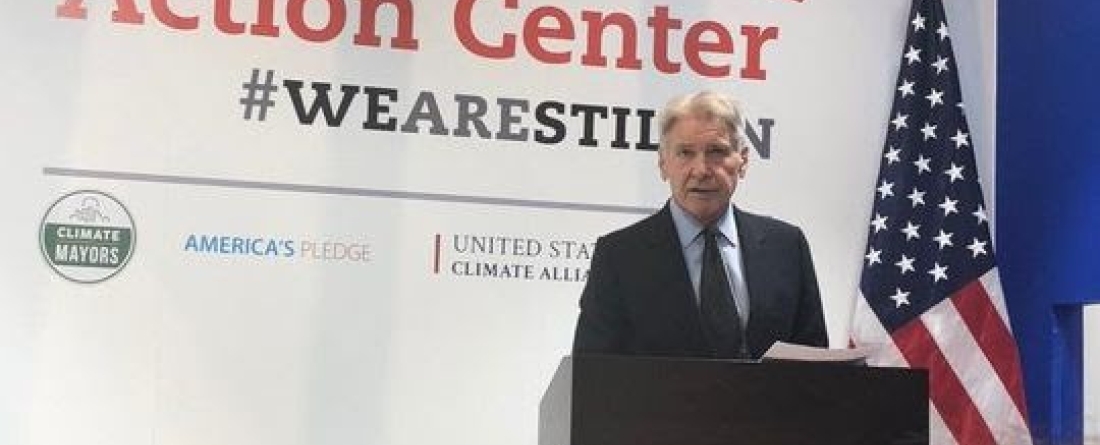
At this year's 25th Conference of the Parties (COP25), CGS helped launch the latest and most comprehensive analysis of US greenhouse gas (GHG) emissions. The report, titled Accelerating America’s Pledge: Going All-In to Build a Prosperous, Low-Carbon Economy for the United States, shows the potential for progress on U.S. emissions reductions from all subnational actors—cities, states, businesses, universities, and more—and if climate-forward leaders are elected at all levels of government in 2020.
To celebrate the launch of the report, America's Pledge hosted an event with international climate leaders such as Patricia Espinosa, Executive Secretary of the United Nations Framework Convention on Climate Change (UNFCCC), actor and environmental activist Harrison Ford, incoming UN Special Envoy for Climate Action and Finance Mark Carney, former Colorado Governor Bill Ritter and others speakers at the U.S. Climate Action Center.
Accelerating America's Pledge captures the power of U.S. states, cities, businesses, and other organizations representing nearly 70 percent of the country’s GDP to reduce emissions and help advance the country toward the Paris Agreement targets. On Tuesday, December 10, 2019, America’s Pledge co-chair and former New York City Mayor Michael R. Bloomberg officially presented the report to the U.N. at the event at COP25.
The report is the first analysis to take the current momentum towards climate leadership among U.S. states, cities, and businesses, and project how far that leadership, without Washington, can take the U.S. by 2030. It then layers onto those projections an analysis of a federal administration that has applied the policies developed and tested at the state and local level on a national scale. The report projects these two emissions reductions scenarios based on city, state, business, and federal adoption of ambitious climate action policies:
- Bottom-Up: The first scenario involves a coalition of states, cities, and businesses deploying aggressive best-practice climate policies informed by the ongoing action of current climate leaders. This is projected to reduce emissions 37 percent below 2005 levels by 2030.
- All-In: The second scenario involves a reengaged federal government layering aggressive, post-2020 climate action onto the bottom-up efforts outlined in scenario one. This would put the U.S. on track to reduce emissions 49 percent below 2005 levels by 2030, in line with the Paris Agreement, and lay the foundation for a net-zero emissions economy by 2050.
The report also projects emissions reductions based on the current trajectory of climate action with existing, on-the-books commitments from non-federal actors and without engagement from the federal government. Existing commitments from the coalition of states, cities, and businesses currently committed to the Paris Agreement would reduce emissions 25 percent below 2005 levels by 2030, significantly faster progress than the report was able to measure only a year ago.
The strategies outlined in the report are organized around three principles that will empower action at all levels of the economy: accelerate toward 100 percent clean electricity and fuels; decarbonize energy end-uses in transportation, buildings, and industry; enhance the carbon storage potential of forests, farms, and coastal wetlands. These steps leverage high-impact opportunities that are available today, while laying the groundwork for steadily deeper emissions reductions after 2030 in order to achieve a carbon-neutral future.
“As the international community seeks to raise global ambition to tackle climate change over the coming year, this report identifies the remarkable scale of action being driven by states, cities, businesses, and others across the United States,” said Nathan Hultman, lead author of the report and director of the Center for Global Sustainability at the University of Maryland. “The report’s results are encouraging, showing a large impact and a pathway to drive ambitious emissions reductions in the United States. The rapidly growing coalition acting on climate in the United States is globally significant, is already delivering significant emissions reductions, and is laying the groundwork for enhanced ambition after 2020. It is also showing the way toward a new model of building climate action based on leadership across all parts of our American federal system.”
“What states, cities, and businesses are doing across the United States is truly impressive. They’re delivering on 100 percent clean electricity, making new buildings zero-emission, and putting electric vehicles on the road,” said Carla Frisch, Principal at Rocky Mountain Institute, which co-led the report. “This analysis is unique in that we started with the cutting-edge actions happening on the ground across the United States and analyzed expanded momentum with and without federal engagement. We found that a comprehensive, all-in climate strategy with bottom-up and federal action could achieve 2030 emissions reductions consistent with limiting global warming to 1.5 degrees Celsius.”
